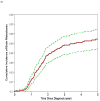Incidence of brain metastases as a first site of recurrence among women with triple receptor-negative breast cancer
- PMID: 22359359
- PMCID: PMC3910255
- DOI: 10.1002/cncr.27434
Incidence of brain metastases as a first site of recurrence among women with triple receptor-negative breast cancer
Abstract
Background: This retrospective study sought to define the incidence of brain metastases as a first site of recurrence among women with triple receptor-negative breast cancer (TNBC).
Methods: A total of 2448 patients with stage I through III TNBC who were diagnosed between 1990 and 2010 were identified. We computed the cumulative incidence of developing brain metastases as a first site of recurrence at 2 and 5 years. Cox proportional hazards models were fitted to determine factors that could predict for the development of brain metastases as a first site of recurrence. The Kaplan-Meier product limit method was used to compute survival following a diagnosis of brain metastases.
Results: At a median follow-up of 39 months, 115 (4.7%) patients had developed brain metastases as a first site of recurrence. The cumulative incidence at 2 and 5 years was 3.7% (95% confidence interval [CI] = 2.9%-4.5%) and 5.4% (95% CI = 4.4%-6.5%), respectively. Among patients with stage I, II, and III disease, the 2-year cumulative incidence of brain metastases was 0.8%, 3.1%, and 8%, respectively (P < .0001). The 5-year cumulative incidence was 2.8%, 4.6%, and 9.6% among patients with stage I, II, and III disease, respectively (P < .0001). In the multivariable model, patients with stage III disease had a significant increase in the risk of developing brain metastases as a first site of recurrence (hazards ratio = 3.51; 95% CI = 1.85-6.67; P = .0001) compared to patients with stage I disease. Those with stage II disease had a nonsignificant increased risk of developing brain metastases as a first site of recurrence (hazards ratio = 1.61; 95% CI = 0.92-2.81; P = .10) compared with patients with stage I disease. Median survival following a diagnosis of brain metastases was 7.2 months (range, 5.7-9.4 months).
Conclusions: Patients with nonmetastatic TNBC have a high early incidence of developing brain metastases as a first site of recurrence, which is associated with subsequent poor survival. Patients with stage III TNBC in particular would be an ideal cohort in which to research preventive strategies.
Copyright © 2012 American Cancer Society.
Figures



References
-
- Jemal A, Siegel R, Xu J, Ward E. Cancer statistics, 2010. CA Cancer J Clin. 2010;60(5):277–300. - PubMed
-
- Lu J, Steeg PS, Price JE, et al. Breast cancer metastasis: challenges and opportunities. Cancer Res. 2009;69(12):4951–3. - PubMed
-
- Lin NU, Bellon JR, Winer EP. CNS metastases in breast cancer. J Clin Oncol. 2004;22(17):3608–17. - PubMed
-
- Tsukada Y, Fouad A, Pickren JW, Lane WW. Central nervous system metastasis from breast carcinoma. Autopsy study Cancer. 1983;52:2349–2354. - PubMed
-
- Patanaphan V, Salazar OM, Risco R. Breast cancer: Metastatic patterns and their prognosis. Southern Medical Journal. 1988;81:1109–1112. - PubMed
Publication types
MeSH terms
Substances
Grants and funding
LinkOut - more resources
Full Text Sources
Medical
Research Materials
Miscellaneous

